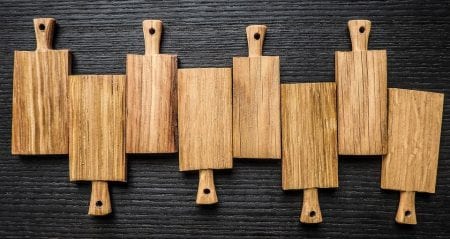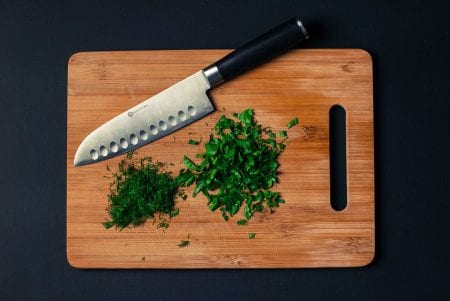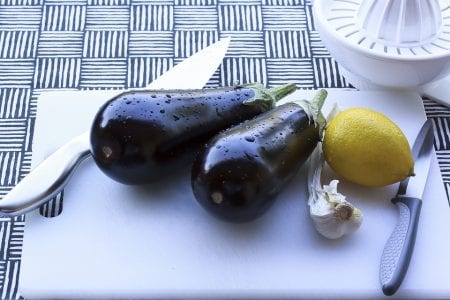
Image Credit: monicore
Buying a new cutting board can cause more questions than you think. Which one is the most hygienic? What kind of board can I wash in the dishwasher? We will tell you everything you need to know about choosing a cutting board in the kitchen.
What are the main types of cutting boards?
WOOD BOARDS
Traditional material for the cutting board is wood. This board is used for cutting meat and fish, vegetables and fruits. The rough surface does not allow these products to slip. It is convenient to cut dough, bakery products. The tree does not blunt the knives and does not make an unpleasant sound when cutting, like glass.
Oak Wood Cutting Board. Oak is considered to be the strongest and hardest tree. Traces of the knife on it will not appear immediately. It will not crack if you cut meat on it or chop nuts. Such a board does not deform from moisture, because the oak is built by ships. Oak, because of the hardness of the rock, does not absorb odors.
If the board with a chess pattern, it is glued from the fragments of the tree. To glue fragments use glue, which can be toxic, the particles of glue in any case will fall into food – for the body it is fraught with poisoning.
A solid oak board is almost an ideal option, except for weight.
Acacia Wood Cutting Board. This is a hard rock. Resistant to scratching from the knife, odor, moisture, strong, solid.
Hevea Wood Cutting Board. This breed worldwide is considered one of the best materials for making cutting boards. Hevea wood is hard and dense, does not crack when cutting meat and fish, is not afraid of water, so it does not deform, practically does not absorb foreign odors, is not immediately damaged by a knife.
IMPORTANT: The narrower the wooden board, the less likely it is that it will bend. This rule works in relation to any tree.
Bamboo Cutting Board. Bamboo boards have a hard surface, resistant to scratching and abrasion, absorb less moisture and odors. But there is one circumstance: since bamboo is not a tree, but a herbaceous plant, cutting boards from it are made on the principle of a laminate for floors. Bamboo is cut into strips, which are then glued together. Important point – when choosing a bamboo board, you need to make sure that the manufacturer did not use formaldehyde glue to glue it. And to be convinced of it it is impossible.

Image Credit: StockSnap
CARE FOR WOODEN BOARDS
1. Before using the wooden board it is recommended to grease with linseed oil – this will save it from absorbing moisture and subsequent deformation.
2. The boards of wood darken from contact with coloring products. Therefore, they should be washed with special care, scalding with boiling water, so the board will retain its appearance for the period of use and will not cause harm to health. But after 2 months the board should be replaced with a new one.
3. Once a week, the boards need to be disinfected. Otherwise, you risk health. If you have one cutting board in your kitchen, and you cut everything on it, the bacteria from raw meat and fish can get into your body with bread or fruit. Rid the board of microbes and the soaked odor will help wipe the lemon juice or vinegar. Relevant and the following procedure: soak the board, sprinkle it with salt, and leave it for a few minutes. Then rinse it thoroughly. Wipe dry with a towel and dry on a ventilated surface.
PLASTIC BOARDS
Planks made of plastic are now very common. The advantages of plastic include: convenience in washing and drying; lightness, and also the price. As a rule, they are cheaper than wooden ones. But planks made of plastic, which are cheaper than wood, cause great doubt among specialists.
The product must have a certificate of quality. You need to ask this document in the store before buying the board. Also look at the packaging, which material is indicated. Polyethylene and propylene are the least harmful types of plastic. In the production of other varieties of plastic, poisonous chemicals are used that can penetrate food products. To buy such boards is a big risk.
The plastic crumbles under the blade of the knife and gets into the body with food. To remove such a foreign toxic substance, the body needs to strengthen the work of the liver and kidneys. For an organism, such loading is tantamount to poisoning. You will feel a general malaise, nausea and other effects of poisoning. If the plastic gets on regularly, then your body is poisoned every day more and more. It threatens with problems with the liver and kidneys.
Also plastic is very inconvenient for cutting meat and fish. In the process of cutting, the board can slide on the surface of the table, which in itself is unpleasant and even fraught with injuries. When making an effort, you can cut yourself with a knife.

Image Credit: stux
Also plastic is not suitable for cutting hot food. If phenol and formaldehyde are released on the surface of a board made from propylene or polyethylene, which are allowed for the manufacture of cutting boards, gets hotter. They are immediately absorbed into the product. Upon ingestion, these substances disrupt the functioning of the kidneys, liver and even impair vision.
GLASS BOARDS
Glass boards are a very fashionable kitchen accessory. But otherwise, as an accessory, they can not be called. Glass cutting boards appeared relatively recently, but have already gained popularity among housewives. Among their advantages can be distinguished original appearance, on such boards there are no traces of knives. The smell from the products on the glass board practically does not remain. Glass boards are easily laundered from contaminants.
There are more drawbacks to this board. The glass board is a very fragile object. On the glass surface knives are blunted too quickly. Please note, if there are not small rubber or silicone feet on the back of the board, the board will constantly stick to the table.
The unpleasant sound of knives on glass is not a test for the faint-hearted. Holds a knife on the glass, a sound is heard. It’s worse than chalking on the board. Professionals use these boards for serving.



